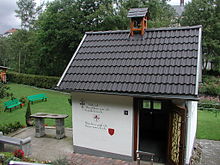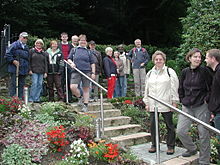Schemm (Ennepetal)
|
Schemm
City of Ennepetal
Coordinates: 51 ° 14 ′ 56 ″ N , 7 ° 18 ′ 11 ″ E
|
||
|---|---|---|
| Height : | 195 m above sea level NN | |
|
Location of Schemm in Ennepetal |
||
|
View from Beyenburg over the Wupper to Schemm
|
||
Schemm is a residential area in the town of Ennepetal in the Ennepe-Ruhr district .
Location and description
Schemm is located on the southwestern edge of the Ennepetal urban area on the Wupper at the foot of the Holberg opposite the historic center of Wuppertal - Beyenburg . The river forms the border between the two cities and at the same time between the two administrative districts of Düsseldorf and Arnsberg and is dammed near the place in the Beyenburger reservoir . A pedestrian bridge connects Beyenburg with Schemm, over which numerous long-distance and local hiking trails are led, including the Beyenburg – Cologne branch of the Rhenish Way of St. James . Below the bridge there is a Wupperfurt near the village.
Other neighboring towns are Friedfeld , Uellenbecke , Fuhr , Ackersiepen , Heide , Holberg , Schultenhof and Hilringhausen on the Ennepetaler and Vor der Hardt , Hengsten , Steinhaus and Siegelberg on the Wuppertal urban area.
history
The Prussian first recording from 1840/1844 shows the place unlabeled. In 1818 15 people lived in the village. In 1839, under the name Am Schemm, Schemm belonged to the Stucken school district of the rural community of Oelkinghausen in the Ennepe district of Hagen , which was converted into the Ennepe district in 1843 . The place categorized as Kotten according to the place and distance table of the government district Arnsberg had two houses at that time. At that time there were 42 people living in the village, 34 of whom were Protestant and eight were Catholic.
The community encyclopedia for the province of Westphalia gives a number of 19 inhabitants for the year 1885, who lived in three houses. Schemm still belonged to the rural community Oelkinghausen of the Ennepe district, which had been assigned to the Schwelm district since 1887 . The edition for 1895 gives two houses and 16 inhabitants, the 1905 edition two houses and 14 inhabitants.
On April 1, 1923, the rural community of Oelkinghausen was dissolved and Schemm came with the rest of the community to the newly founded community of Milspe , which became part of the city of Ennepetal on April 1, 1949.
The Maria Schnee chapel
In 2009 the Maria Schnee chapel was consecrated in Schemm on the Way of St. James and has been a popular place of worship ever since.
On Christmas Day 2008, after the traditional annual family crib hike, the participants met in Beyenburg and discussed the topic of “miracles”. One of them reported that he had discovered a circle with a cross in the snow on February 2nd, 2008 at the time of Candlemas on the meadow at the monastery church, while inside the "old Madonna" was standing on a wagon wheel. He interpreted this as a vision of Saint Mary in the snow, photographed the apparition and gave the picture to the participants to see. A pastor who took part suggested building a chapel at this location.
Then plans for the construction of the chapel were forged and a citizen of Beyenburg made available a small piece of land that had decayed over time, on which there was a goat shed that was later used as a wash house and was now slowly falling into disrepair. Many volunteers put in working hours for the renovation and renovation until the small chapel within sight of the Beyenburg monastery church was completed and inaugurated in September . Brother Dirk Wasserfuhr inherited a statue of “Maria in the Snow” from the Order of the Cross from an estate and brought it in. Since then, the Black Madonna and Child has been venerated here. A 51-armed candlestick stands next to the statue.
The auxiliary bishop of Cologne visited the new chapel for the inauguration ceremony on September 11, 2009 . When Cardinal Joachim Meisner came to Beyenburg for the 800th anniversary of the Order of the Cross, he was enthusiastic and surprised.
The chapel is quite small, inside only has space for a maximum of ten people and outside a stone altar. There are now constant visitors to the consecrated place of worship “Am Schemm” near the Wupper . 50 to 60 tea lights are lit here every day .
On August 5th, the consecration of the Roman patriarchal basilica " Santa Maria Maggiore " in 432, which is associated with the legend of the snow miracle, is remembered annually, especially in Italy .
The chapel is on the route of the Bergisches Jakobsweg.
Individual evidence
- ↑ Johann Georg von Viebahn : Local and distance table of the government district Arnsberg, arranged according to the existing state division, with details of the earlier areas and offices, the parish and school districts and topographical information. Ritter, Arnsberg 1841.
- ↑ Royal Statistical Bureau (Prussia) (Ed.): Community encyclopedia for the province of Westphalia. Based on the materials of the census of December 1, 1885 and other official sources (= community encyclopedia for the Kingdom of Prussia. Volume X), Berlin 1887.
- ↑ Royal Statistical Bureau (Prussia) (Ed.): Community encyclopedia for the province of Westphalia. Based on the materials from the census of December 1, 1885 and other official sources (= community encyclopedia for the Kingdom of Prussia. Volume X), Berlin 1909.
- ↑ a b c d Hans-Jochem Schulte: An apparition leads to "Maria im Schnee". In: Westdeutsche Allgemeine Zeitung . July 24, 2014, accessed March 30, 2015 .
- ↑ Bärbel Voogt-Müller: An old goat barn became the “Maria im Schnee” pilgrimage site. In: Westdeutsche Zeitung . December 29, 2010, accessed March 30, 2015 .
- ↑ Map showing the Way of St. James on the aforementioned “Am Schemm” road to Lüttringhausen
- ↑ Current description of the Bergisch Jakobsweg with pictures .
- ↑ For the first time, the Sunday paper, Wuppertal, issue of September 5, 2010 reported on the visit of the Wuppertal city dean on a stage of the pilgrimage.





